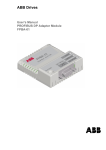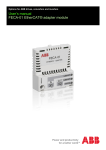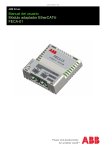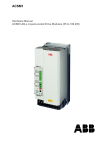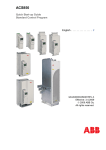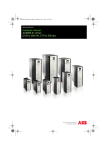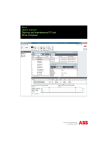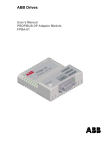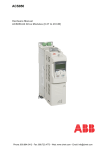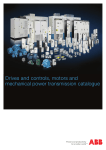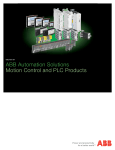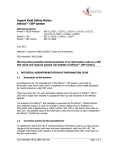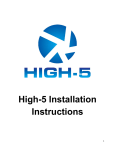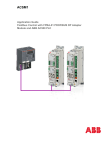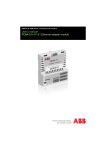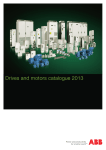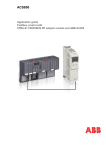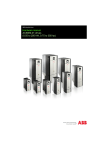Download EN / FSCA-01 RS-485 adapter module user`s manual
Transcript
ABB fieldbus options User’s manual FSCA-01 RS-485 adapter module Gross Automation 3680 N. 126th St. Brookfield, WI 53005 877-268-3700 [email protected] www.abbdrivesales.com List of related manuals See section Related manuals on page 14. 877-268-3700 Gross Automation [email protected] 3680 N. 126th St. Brookfield, WI 53005 www.abbdrivesales.com User’s manual FSCA-01 RS-485 adapter module Table of contents 1. Safety 4. Mechanical installation 5. Electrical installation 6. Start-up 3AUA0000109533 Rev A EN EFFECTIVE: 2011-12-22 Gross Automation 877-268-3700 3680 N. 126th St. [email protected] Brookfield, WI 53005 www.abbdrivesales.com © 2011 ABB Oy All Rights Reserved. Table of contents 5 Table of contents 1. Safety What this chapter contains . . . . . . . . . . . . . . . . . . . . . . . . . . . . . . 9 Use of warnings . . . . . . . . . . . . . . . . . . . . . . . . . . . . . . . . . . . . . 10 Safety in installation . . . . . . . . . . . . . . . . . . . . . . . . . . . . . . . . . . 11 2. About the manual What this chapter contains . . . . . . . . . . . . . . . . . . . . . . . . . . . . . Applicability . . . . . . . . . . . . . . . . . . . . . . . . . . . . . . . . . . . . . . . . Compatibility . . . . . . . . . . . . . . . . . . . . . . . . . . . . . . . . . . . . . . . Target audience . . . . . . . . . . . . . . . . . . . . . . . . . . . . . . . . . . . . . Purpose of the manual . . . . . . . . . . . . . . . . . . . . . . . . . . . . . . . . Related manuals . . . . . . . . . . . . . . . . . . . . . . . . . . . . . . . . . . . . Before you start . . . . . . . . . . . . . . . . . . . . . . . . . . . . . . . . . . . . . Contents . . . . . . . . . . . . . . . . . . . . . . . . . . . . . . . . . . . . . . . . . . . Terms and abbreviations used in this manual . . . . . . . . . . . . . . General terms and abbreviations . . . . . . . . . . . . . . . . . . . . Modbus terms and abbreviations . . . . . . . . . . . . . . . . . . . . 13 13 13 14 14 14 16 16 17 17 18 3. Overview of the RS-485 network and the FSCA-01 module What this chapter contains . . . . . . . . . . . . . . . . . . . . . . . . . . . . . RS-485 network . . . . . . . . . . . . . . . . . . . . . . . . . . . . . . . . . . . . . Example topology of the RS-485 link . . . . . . . . . . . . . . . . . FSCA-01 RS-485 adapter module . . . . . . . . . . . . . . . . . . . . . . . Layout of the adapter module . . . . . . . . . . . . . . . . . . . . . . . 19 19 21 22 23 4. Mechanical installation What this chapter contains . . . . . . . . . . . . . . . . . . . . . . . . . . . . . 25 Delivery check . . . . . . . . . . . . . . . . . . . . . . . . . . . . . . . . . . . . . . 25 Mounting the adapter module . . . . . . . . . . . . . . . . . . . . . . . . . . 26 Gross Automation 3680 N. 126th St. Brookfield, WI 53005 877-268-3700 [email protected] www.abbdrivesales.com 6 Table of contents 5. Electrical installation What this chapter contains . . . . . . . . . . . . . . . . . . . . . . . . . . . . . 27 General cabling instructions . . . . . . . . . . . . . . . . . . . . . . . . . . . . 27 Connecting the module to the RS-485 network . . . . . . . . . . . . . 28 Switching on the bus termination . . . . . . . . . . . . . . . . . . . . . . . . 29 6. Start-up What this chapter contains . . . . . . . . . . . . . . . . . . . . . . . . . . . . . 31 Drive configuration . . . . . . . . . . . . . . . . . . . . . . . . . . . . . . . . . . . 32 Modbus/RTU connection configuration . . . . . . . . . . . . . . . . 32 FSCA-01 configuration parameters – group A (group 1) 33 FSCA-01 configuration parameters – group B (group 2) 41 FSCA-01 configuration parameters – group C (group 3) 42 Control locations . . . . . . . . . . . . . . . . . . . . . . . . . . . . . . . . . 43 Starting up ACS355 drives . . . . . . . . . . . . . . . . . . . . . . . . . . . . . 44 Parameter setting examples – ACS355 . . . . . . . . . . . . . . . . 45 Speed and torque control using the ABB Drives Enhanced communication profile . . . . . . . . . . . . . . . . . . 45 Starting up ACSM1 drives . . . . . . . . . . . . . . . . . . . . . . . . . . . . . 48 Parameter setting examples – ACSM1 . . . . . . . . . . . . . . . . 49 Speed and torque control using the ABB Drives Enhanced communication profile . . . . . . . . . . . . . . . . . . 49 Starting up ACS880 drives . . . . . . . . . . . . . . . . . . . . . . . . . . . . . 53 Parameter setting examples – ACS880 . . . . . . . . . . . . . . . . 54 Speed control using the ABB Drives - Enhanced communication profile. . . . . . . . . . . . . . . . . . . . . . . . . . . 54 Configuring the master station . . . . . . . . . . . . . . . . . . . . . . . . . . 57 Modbus register maps . . . . . . . . . . . . . . . . . . . . . . . . . . . . . 57 7. Communication profiles What this chapter contains . . . . . . . . . . . . . . . . . . . . . . . . . . . . . 59 Communication profiles . . . . . . . . . . . . . . . . . . . . . . . . . . . . . . . 59 ABB Drives communication profile . . . . . . . . . . . . . . . . . . . . . . . 61 Control word and Status word . . . . . . . . . . . . . . . . . . . . . . . 61 Control word contents. . . . . . . . . . . . . . . . . . . . . . . . . . . 61 Status word contents . . . . . . . . . . . . . . . . . . . . . . . . . . . 63 Table of contents 7 State machine . . . . . . . . . . . . . . . . . . . . . . . . . . . . . . . . References . . . . . . . . . . . . . . . . . . . . . . . . . . . . . . . . . . . . . Scaling . . . . . . . . . . . . . . . . . . . . . . . . . . . . . . . . . . . . . . Actual values . . . . . . . . . . . . . . . . . . . . . . . . . . . . . . . . . . . . Scaling . . . . . . . . . . . . . . . . . . . . . . . . . . . . . . . . . . . . . . 65 66 66 67 67 8. Communication protocol What this chapter contains . . . . . . . . . . . . . . . . . . . . . . . . . . . . . Modbus/RTU . . . . . . . . . . . . . . . . . . . . . . . . . . . . . . . . . . . . . . . Register addressing . . . . . . . . . . . . . . . . . . . . . . . . . . . . . . . . . . Function codes . . . . . . . . . . . . . . . . . . . . . . . . . . . . . . . . . . . . . . Encapsulated interface transport / Read device identification . . Exception codes . . . . . . . . . . . . . . . . . . . . . . . . . . . . . . . . . . . . . Communication profiles . . . . . . . . . . . . . . . . . . . . . . . . . . . . . . . ABB Drives profile - Classic . . . . . . . . . . . . . . . . . . . . . . . . . ABB Drives profile - Enhanced . . . . . . . . . . . . . . . . . . . . . . Transparent 16-bit . . . . . . . . . . . . . . . . . . . . . . . . . . . . . . . . Transparent 32-bit . . . . . . . . . . . . . . . . . . . . . . . . . . . . . . . . 69 69 70 70 72 73 73 74 75 77 78 9. Diagnostics What this chapter contains . . . . . . . . . . . . . . . . . . . . . . . . . . . . . 81 LED indications . . . . . . . . . . . . . . . . . . . . . . . . . . . . . . . . . . . . . 82 Internal error code registers . . . . . . . . . . . . . . . . . . . . . . . . . . . . 83 10. Technical data What this chapter contains . . . . . . . . . . . . . . . . . . . . . . . . . . . . . 85 FSCA-01 . . . . . . . . . . . . . . . . . . . . . . . . . . . . . . . . . . . . . . . . . . 85 RS-485 link . . . . . . . . . . . . . . . . . . . . . . . . . . . . . . . . . . . . . . . . 86 Further information Product and service inquiries . . . . . . . . . . . . . . . . . . . . . . . . . . . Product training . . . . . . . . . . . . . . . . . . . . . . . . . . . . . . . . . . . . . Providing feedback on ABB Drives manuals . . . . . . . . . . . . . . . Document library on the Internet . . . . . . . . . . . . . . . . . . . . . . . . 87 87 87 87 8 Table of contents Safety 9 Safety What this chapter contains The chapter presents the warning symbols used in this manual and the safety instructions which you must follow when installing an optional module into a drive, converter or inverter. If ignored, physical injury or death may follow, or damage may occur to the equipment. Read this chapter before you start the installation. 10 Safety Use of warnings Warnings caution you about conditions which can result in serious injury or death and/or damage to the equipment and advise on how to avoid the danger. The following warning symbols are used in this manual: Electricity warning warns of hazards from electricity which can cause physical injury and/or damage to the equipment. General warning warns about conditions, other than those caused by electricity, which can result in physical injury and/or damage to the equipment. Safety 11 Safety in installation These warnings are intended for all who install an optional module into a drive, converter or inverter. WARNING! Ignoring the following instructions can cause physical injury or death, or damage to the equipment. • Only qualified electricians are allowed to install and maintain the drive, converter or inverter! • Disconnect the drive, converter or inverter into which the module will be installed from all possible power sources. After disconnecting, always wait for 5 minutes to let the intermediate circuit capacitors discharge before you proceed. • Always ensure by measuring with a multimeter (impedance at least 1 Mohm) that: • • there is no voltage between the input power terminals of the drive, converter or inverter and the ground • there is no voltage between the output power terminals of the drive, converter or inverter and the ground. Do not work on the control cables when power is applied to the external control circuits of the drive, converter or inverter. Externally supplied control circuits may carry dangerous voltage. 12 Safety About the manual 13 About the manual What this chapter contains This chapter introduces this manual. Applicability This manual applies to the FSCA-01 RS-485 adapter module (+K458), SW version 1.500 or later. Compatibility The FSCA-01 RS-485 adapter module is compatible with the following drives: • ACS355 • • • • ACSM1 ACS850 ACQ810 ACS880. The FSCA-01 RS-485 adapter module supports the Modbus/RTU communication protocol. Support for the DCP protocol to be used with ACSM1 Lift control program is pending. 14 About the manual The FSCA-01 RS-485 adapter module is compatible with all Modbus/RTU masters that support Modbus Application Protocol Specification v1.1b and MODBUS over Serial Line Specification and Implementation Guide v1.02. Target audience The reader is expected to have a basic knowledge of the fieldbus interface, electrical fundamentals, electrical wiring practices and how to operate the drive. Purpose of the manual The manual provides information on installing, commissioning and using an FSCA-01 RS-485 adapter module. Related manuals The related manuals are listed below. Code (English) Drive user’s manuals ACS355 drives (0.37…22 kW, 0.5…30 hp) user’s manual Drive hardware manuals and guides ACSM1-204 regen supply modules (5.3 to 61 kW) hardware manual ACSM1-04 drive modules (0.75 to 45 kW) hardware manual ACSM1-04 drive modules (55 to 110 kW) hardware manual ACSM1-04Lx liquid-cooled drive modules (55 to 160 kW) hardware manual ACS850-04 (0.37…45 kW) hardware manual ACS850-04 (55…160 kW, 75…200 hp) hardware manual ACS850-04 (200…500 kW, 250…600 hp) hardware manual 3AUA0000066143 3AUA0000053713 3AFE68797543 3AFE68912130 3AUA0000022083 3AUA0000045496 3AUA0000045487 3AUA0000026234 About the manual 15 Code (English) 3AUA0000055160 ACQ810-04 drive modules (0.37…45 kW, 0.5…60 hp) hardware manual ACQ810-04 drive modules (55 to 3AUA0000055161 160 kW, 75 to 200 hp) hardware manual ACQ810-04 drive modules 3AUA0000055155 (200…400 kW, 250…600 hp) hardware manual ACS880-01 (0.55 to 250 kW, 0.75 to 3AUA0000078093 350 hp) hardware manual Drive firmware manuals and guides ACSM1 motion control program firmware manual ACSM1 speed and torque control program firmware manual ACSM1 regen supply control program firmware manual ACS850 standard control program firmware manual ACQ810 standard pump control program firmware manual ACS880 primary control program firmware manual Option manuals and guides FSCA-01 RS-485 adapter module user’s manual 3AFE68848270 3AFE68848261 3AUA0000052174 3AUA0000045497 3AUA0000055144 3AUA0000085967 3AUA0000109533 You can find manuals and other product documents in PDF format on the Internet. See section Document library on the Internet on the inside of the back cover. For manuals not available in the Document library, contact your local ABB representative. 16 About the manual Before you start It is assumed that the drive is installed and ready to operate before you start the installation of the adapter module. In addition to conventional installation tools, have the drive manuals available during the installation as they contain important information not included in this manual. The drive manuals are referred to at various points of this manual. Contents The manual consists of the following chapters: • Safety presents the safety instructions which you must follow when installing a fieldbus adapter module. • • About the manual introduces this manual. • Mechanical installation contains a delivery checklist and instructions on mounting the adapter module. • Electrical installation contains instructions on cabling, connecting the module to the RS-485 network and bus termination. • Start-up presents the steps to take during the start-up of the drive with the adapter module and gives information on configuring the master. • Communication profiles describes the communication profiles used in the communication between the master, the adapter module and the drive. • Communication protocol describes the Modbus/RTU communication protocol for the adapter module. • Diagnostics explains how to trace faults with the status LEDs on the adapter module. • Technical data contains the technical data of the adapter module and the RS-485 link. Overview of the RS-485 network and the FSCA-01 module contains a short description of the RS-485 network and the adapter module. About the manual 17 Terms and abbreviations used in this manual General terms and abbreviations Term/abbreviation Explanation Communication module Communication module is a name for a device (eg, a fieldbus adapter) through which the drive is connected to an external communication network (eg, a fieldbus). The communication with the module is activated with a drive parameter. Command word See Control word. Control word 16-bit word from master to slave with bit-coded control signals (sometimes called the Command word). EIA-485 Balanced (differential) serial interface standard. Also known as TIA-485 or RS-485. In this manual, term RS-485 is used. FSCA-01 RS-485 adapter module One of the optional fieldbus adapter modules available for ABB drives. FSCA-01 is a device through which an ABB drive is connected to an RS-485 network. Parameter Operating instruction for the drive. Parameters can be read and programmed with the drive control panel, drive PC tools or through the adapter module. Profile Adaptation of the protocol for certain application field, for example, drives. In this manual, drive-internal profiles (eg, DCU or FBA) are called native profiles. Status word 16-bit word from slave to master with bit-coded status messages TIA/EIA ANSI Telecommunication Industry Association/Electronic Industries Alliance 18 About the manual Modbus terms and abbreviations Term Explanation Exception code If an error related to the requested Modbus function occurs, the data field contains an exception code that the server application can use to determine the next action to be taken. Function code The second byte sent by the client. The function indicates to the server what kind of action to perform. Holding register Holds data that will be later executed by an application program. Overview of the RS-485 network and the FSCA-01 module 19 Overview of the RS-485 network and the FSCA-01 module What this chapter contains This chapter contains a short description of the RS-485 network and the FSCA-01 RS-485 adapter module. RS-485 network RS-485 (EIA-485, TIA-485) is a balanced (differential) serial interface standard for communication over a twisted-pair cable. Because the RS-485 signal transmission is differential, it provides better protection against noise and longer transmission distances than RS-232. RS-485 is a half-duplex multi-drop network, which means that multiple devices may reside on line. Only one transmitter may be active at any given time. The RS-485 standard specifies only the electrical characteristics of the bus system. The communication protocol and communication speed depend on the application used. For example, the electrical characteristics of the Modbus protocol are based on the RS-485 standard. 20 Overview of the RS-485 network and the FSCA-01 module The RS-485 transmission line consists of two wires, A and B (balanced pair). The signal transmission is based on the voltage difference between the wires. The minimum detected voltage difference is 200 mV. The potential difference between the two wires determines the logic state bit: when B is at a higher voltage than A, the state is defined as bit 1 (data high) and when A is at a higher voltage than B, the state is defined as bit 0 (data low). The maximum common mode voltage between RS-485 network devices is limited to -7…+12 V. A ground wire and cable shield should be connected to prevent the common mode voltage between the network devices from drifting outside the allowable limits. The RS-485 bus cable should be terminated with a 120 ohm resistor at both ends to prevent signal reflection. When no device on the network is transmitting, noise can be falsely interpreted as communication data. To avoid this, a termination can be included with a fail-safe circuit (pull-up and pull-down resistors). The circuit forces the bus into a known idle state when no device is transmitting. Overview of the RS-485 network and the FSCA-01 module 21 Example topology of the RS-485 link An example of an allowable topology is shown below. RS-485 master ABB drive Other slave device ABB drive ABB drive Other slave device ABB drive T Other slave device T T = Termination 22 Overview of the RS-485 network and the FSCA-01 module FSCA-01 RS-485 adapter module The FSCA-01 RS-485 adapter module is an optional device for ABB drives which enables the connection of the drive to an RS-485 network. The adapter module provides galvanic isolation between the drive and RS-485 network and converts the serial communication signals of the drive to the RS-485 signal levels. The adapter module has a built-in bus termination with fail-safe circuitry. The termination can be activated with a jumper. For instructions, see chapter Electrical installation. Through the adapter module you can: • give control commands to the drive (for example, Start, Stop, Run enable) • • feed a motor speed or torque reference to the drive • • • read status information and actual values from the drive give a process actual value or a process reference to the PID controller of the drive change drive parameter values reset a drive fault. The communication protocol used to access these functionalities over the RS-485 connection is described in chapter Communication protocol. The adapter module is mounted into an option slot on the motor control board of the drive. See the drive manuals for module placement options. Overview of the RS-485 network and the FSCA-01 module 23 Layout of the adapter module Diagnostic LEDs (see chapter Diagnostics) Termination jumper J2 (see chapter Electrical installation) Mounting screw Bus connector X1 (see chapter Electrical installation) 24 Overview of the RS-485 network and the FSCA-01 module Mechanical installation 25 Mechanical installation What this chapter contains This chapter contains a delivery checklist and instructions on mounting the adapter module. WARNING! Follow the safety instructions given in this manual and the drive documentation. Delivery check The option package for the adapter module contains: • RS-485 adapter module, type FSCA-01 • this manual. 26 Mechanical installation Mounting the adapter module The adapter module is to be inserted into its specific position in the drive. The module is held in place with plastic pins and one screw. The screw also provides the electrical connection between the module and drive frame for cable shield termination. When the module is installed, the signal and power connection to the drive is made through a 20-pin connector. (All drives do not use all the available signals so the connector on the drive may have fewer pins.) Mounting procedure: 1. Insert the module carefully into its position on the drive. 2. Fasten the screw. Note: It is essential to install the screw properly to fulfill the EMC requirements and to ensure the proper operation of the module. For more information on mounting, see the drive manuals. Electrical installation 27 Electrical installation What this chapter contains This chapter contains: • general cabling instructions • • instructions on connecting the module to the RS-485 network instructions on switching on the bus termination. WARNING! Before installation, switch off the drive power supply. Wait five minutes to ensure that the capacitor bank of the drive is discharged. Switch off all dangerous voltages connected from external control circuits to the inputs and outputs of the drive. General cabling instructions • Arrange the bus cables as far away from the motor cables as possible. • • Avoid parallel runs. Use bushings at cable entries. 28 Electrical installation Connecting the module to the RS-485 network Connect the bus cable to connector X1 on the adapter module. The pin allocation of the X1 connector is shown below. 1 2 X1 3 4 Description 1 SHLD Bus cable shield. Connected internally to GND_B and CH_GND (chassis) via RC filters. 2 DATA_B Data positive 3 DATA_A Data negative 4 GND_B Isolated signal ground Electrical installation 29 Switching on the bus termination Bus termination is required to prevent signal reflections from the bus cable ends. The adapter module is equipped with internal bus termination, which is configurable with jumper J2 pins. Activate the termination on the devices located at the bus ends and deactivate it on the other devices. See the figure below. J2 J2 Termination activated Termination deactivated Termination deactivated Termination activated RS-485 device RS-485 device RS-485 device RS-485 device Term. Term. Term. Term. ON OFF J2 OFF J2 ON 30 Electrical installation Start-up 31 Start-up What this chapter contains This chapter contains: • information on configuring the drive for operation with the adapter module • drive-specific instructions and examples on starting up the drive with the adapter module • information on configuring the master station for communication with the adapter module. WARNING! Follow the safety instructions given in this manual and the drive documentation. 32 Start-up Drive configuration The following information applies to all drive types compatible with the adapter module, unless otherwise stated. Modbus/RTU connection configuration After the adapter module has been mechanically and electrically installed according to the instructions in chapters Mechanical installation and Electrical installation, you must prepare the drive for communication with the module. The detailed procedure of activating the module for Modbus/RTU communication with the drive depends on the drive type. Normally, you must adjust a parameter to activate the communication. See the drive-specific start-up procedures starting on page 44. Once communication between the drive and the adapter module has been established, several configuration parameters are copied to the drive. These parameters are shown in the tables below and must be checked first and adjusted where necessary. Note that not all drives display descriptive names for the configuration parameters. To help you identify the parameters in different drives, the names displayed by each drive are given in grey boxes in the tables. Note: The new settings take effect only when the adapter module is powered up the next time or when the fieldbus adapter refresh parameter is activated. Start-up 33 FSCA-01 configuration parameters – group A (group 1) Note: The actual parameter group number depends on the drive type. Group A (group 1) corresponds to: • parameter group 51 in ACS355, ACSM1, ACS850 and ACQ810 • parameter group 51 in ACS880 if the adapter is installed as fieldbus adapter A or group 54 if the adapter is installed as fieldbus adapter B. No. Name/Value Description Default 01 FBA TYPE Read-only. Shows the fieldbus adapter type as detected by the drive. The value cannot be adjusted by the user. If the value is 0 = None, the communication between the drive and the module has not been established. 485 = RS-485 02 PROFILE Selects the communication profile for the network connection. Note: The communication protocol is selected with parameter 25 PROTOCOL. 0 = ABB Classic ACS355: FB PAR 2 ACSM1: FBA PAR2 ACS850/ACQ810: FBA par2 ACS880: Profile 0 = ABB Classic Modbus/RTU protocol with ABB Drives profile - Classic 1 = ABB Enhanced Modbus/RTU protocol with ABB Drives profile - Enhanced 2 = Transp 16 Modbus/RTU protocol with Transparent 16bit profile 3 = Transp 32 Modbus/RTU protocol with Transparent 32bit profile 34 Start-up No. Name/Value Description Default 03 STATION ID Defines the address of the device. Two units with the same address are not allowed on-line. 1 ACS355: FB PAR 3 ACSM1: FBA PAR3 ACS850/ACQ810: FBA par3 ACS880: Station ID 04 1…247 Address of the device BAUD RATE Selects the baud rate of the link. 0 = 9.6 kbit/s ACS355: FB PAR 4 ACSM1: FBA PAR4 ACS850/ACQ810: FBA par4 ACS880: Baud rate 05 0 = 9.6 kbit/s 9.6 kbit/s 1 = 19.2 kbit/s 19.2 kbit/s 2 = 38.4 kbit/s 38.4 kbit/s 3 = 57.6 kbit/s 57.6 kbit/s 4 = 115.2 kbit/s 115.2 kbit/s PARITY Defines the use of parity and stop bit(s) and the data length. The same settings must be used in all on-line stations. ACS355: FB PAR 5 ACSM1: FBA PAR5 ACS850/ACQ810: FBA par5 ACS880: Parity 0 = 8 None 1 No parity bit, one stop bit, 8 data bits 1 = 8 None 2 No parity bit, two stop bits, 8 data bits 2 = 8 Even 1 Even parity indication bit, one stop bit, 8 data bits 0 = 8 None 1 Start-up 35 No. 06 Name/Value Description 3 = 8 Odd 1 Odd parity indication bit, one stop bit, 8 data bits MODBUS TIMEOUT The Modbus/RTU protocol does not specify a timeout mechanism for the application layer. ABB Drives and the FSCA-01 module provide a Modbus timeout method as it may be desired for drive control. The timeout is: ACS355: FB PAR 6 ACSM1: FBA PAR6 ACS850/ACQ810: FBA par6 ACS880: Modbus timeout Default 0 (MODBUS TIMEOUT value) * 100 milliseconds For example, a MODBUS TIMEOUT value of 22 would result in a timeout of: 22 * 100 milliseconds = 2.2 seconds When a Modbus timeout occurs, the adapter module signals the drive that communication with the master has been lost. The drive configuration determines how it responds. Example: If you configure the MODBUS TIMEOUT as 250 ms and the drive is configured to fault on a communication failure with a delay of 500 ms, then the drive faults 750 ms after the communication is lost. 07 0…65535 Modbus timeout value TIMEOUT MODE Selects which Modbus register accesses reset the timeout counter. ACS355: FB PAR 7 ACSM1: FBA PAR7 ACS850/ACQ810: FBA par7 ACS880: Timeout mode 0 = None Modbus timeout feature is disabled. 1 = Any message Timeout counter is reset when any Modbus register of the drive is accessed. 2 = Ctrl write Timeout counter is reset when the drive receives either a new Control word or new reference value (REF1 or REF2) from the Modbus master. 0 = None 36 Start-up No. Name/Value Description Default 08 OK MESSAGES Read-only. Shows the number of valid messages which the drive has received. 0 ACS355: FB PAR 8 ACSM1: FBA PAR8 ACS850/ACQ810: FBA par8 ACS880: OK messages 09 0…65535 Number of valid messages CRC ERRORS Read-only. Shows the number of messages with a cyclic redundancy check (CRC) error which the drive has received. If the number is high, check the CRC calculation for possible errors. Note: High electromagnetic noise levels may generate errors. ACS355: FB PAR 9 ACSM1: FBA PAR9 ACS850/ACQ810: FBA par9 ACS880: CRC errors 10 0…65535 Number of messages with a CRC error UART ERRORS Read-only. Shows the number of messages which the drive has received with other communication errors. ACS355: FB PAR 10 ACSM1: FBA PAR10 ACS850/ACQ810: FBA par10 ACS880: UART errors 11 0…65535 Number of messages with other communication errors WORD ORDER Selects in which order the 16-bit registers of 32-bit parameters are transferred. For each register (16-bit), the first byte contains the high order byte and the last byte contains the low order byte. ACS355: FB PAR 11 ACSM1: FBA PAR11 ACS850/ACQ810: FBA par11 ACS880: Word order 0 0 1 = HILO Start-up 37 No. Name/Value Description 0 = LOHI The first register contains the low order word and the second register contains the high order word. 1 = HILO The first register contains the high order word and the second register contains the low order word. 12 … 23 Reserved These parameters are not used by the adapter module. N/A 24 PROTOCOL CHECK 1 ACS355: FB PAR 24 ACSM1: FBA PAR24 ACS850/ACQ810: FBA par24 ACS880: Protocol check Read only. Shows whether the parameters of the selected communication protocol have been loaded to the module. - If the value of this parameter corresponds to the setting of par. 25 PROTOCOL, it means that the parameters have been loaded. - If the value of this parameter differs from the setting of par. 25, load the parameters by setting par. 27 FBA PAR REFRESH to 1 = Refresh / Configure. 0…5 Communication protocol check PROTOCOL Selects the communication protocol for the network connection. 25 ACS355: FB PAR 25 ACSM1: FBA PAR25 ACS850/ACQ810: FBA par25 ACS880: Protocol 0 No protocol selected 1 = Modbus Modbus/RTU protocol selected 2 = N2 N/A 3 = FLN N/A 4 = BACnet N/A 5 = DCP N/A Default 1 = Modbus 38 Start-up No. Name/Value Description Default 26 PROTOCOL SW VER Read only. Shows the software version of the communication protocol currently selected. N/A ACS355: FB PAR 26 ACSM1: FBA PAR26 ACS850/ACQ810: FBA par26 ACS880: Protocol sw ver Version of the communication protocol 27 FBA PAR REFRESH ACS355/ACSM1: FBA PAR REFRESH ACS850/ACQ810/ ACS880: FBA par refresh 28 Validates any changed adapter module configuration parameter settings. After refreshing, the value reverts automatically to 0 = Done. Note: This parameter cannot be changed while the drive is running. 0 = Done Refreshing done 1 = Refresh / Configure Refreshing PAR TABLE VER Read-only. Displays the parameter table revision of the fieldbus adapter module mapping file stored in the memory of the drive. In format xyz, where x = major revision number y = minor revision number z = correction number OR in format axyz, where a = major revision number xy = minor revision number z = correction number or letter. ACS355: FILE CPI FW REV ACSM1: PAR TABLE VER ACS850/ACQ810/ ACS880: Par table ver Parameter table revision 0 = Done N/A Start-up 39 No. Name/Value Description Default 29 DRIVE TYPE CODE Read-only. Displays the drive type code of the fieldbus adapter module mapping file stored in the memory of the drive. N/A ACS355: FILE CONFIG ID ACSM1: DRIVE TYPE CODE ACS850/ACQ810/ ACS880: Drive type code Drive type code of the fieldbus adapter module mapping file 30 MAPPING FILE VER ACS355: FILE CONFIG REV ACSM1: MAPPING FILE VER ACS850/ACQ810/ ACS880: Mapping file ver Read-only. Displays the fieldbus adapter module mapping file revision stored in the memory of the drive in decimal format. N/A Mapping file revision 31 D2FBA COMM STA ACS355: FBA STATUS ACSM1: D2FBA COMM STA ACS850/ACQ810/ ACS880: D2FBA comm sta Read-only. Displays the status of the fieldbus adapter module communication. Note: The value names may vary by drive. 0 = Idle Adapter is not configured. 1 = Exec.init Adapter is initializing. 2 = Time out A timeout has occurred in the communication between the adapter and the drive. 0 = Idle OR 4 = Off-line 40 Start-up No. 32 Name/Value Description 3 = Conf.err Adapter configuration error: The major or minor revision code of the common program revision in the fieldbus adapter module is not the revision required by the module or mapping file upload has failed more than three times. 4 = Off-line Adapter is off-line. 5 = On-line Adapter is on-line. 6 = Reset Adapter is performing a hardware reset. FBA COMM SW VER Read-only. Displays the common program revision of the adapter module in format axyz, where: a = major revision number xy = minor revision number z = correction number or letter. ACS355: FBA CPI FW REV ACSM1: FBA COMM SW VER ACS850/ACQ810/ ACS880: FBA comm SW ver Default N/A Common program version of the adapter module 33 FBA APPL SW VER ACS355: FBA APPL FW REV ACSM1: FBA APPL SW VER ACS850/ACQ810/ ACS880: FBA appl SW ver Read-only. Displays the application program revision of the adapter module in format axyz, where: a = major revision number xy = minor revision number z = correction number or letter. Application program revision of the adapter module N/A Start-up 41 FSCA-01 configuration parameters – group B (group 2) Note: The actual parameter group number depends on the drive type. Group B (group 2) corresponds to: • parameter group 55 in ACS355 • • parameter group 53 in ACSM1, ACS850 and ACQ810 parameter group 53 in ACS880 if the adapter is installed as fieldbus adapter A or group 56 if the adapter is installed as fieldbus adapter B. No.1) Name/Value Description Default 01 DATA OUT 1 (master to drive) Selects the drive parameter address into which the value of the DATA OUT 1 register is written (from the master to the server). The Modbus register address maps are explained in chapter Communication protocol. The content is defined by a decimal number in the range of 0 to 9999 as follows: 0 = None ACS355: FBA DATA OUT 1 ACSM1: FBA DATA OUT1 ACS850/ACQ810/ ACS880: FBA data out1 02… 12 1) 0 Not used 1…99 Virtual address area of drive control. Not used with Modbus/RTU. 101… 9999 Parameter area of the drive 0 = None Not used 101…9999 Parameter index with format xxyy, where • xx is the parameter group number (1…99) • yy is the parameter number index within that group (01…99). Other (ACS880 only) Path to parameter area selection (ACS880 only) DATA OUT 2… DATA OUT 12 See parameter 01 DATA OUT 1. 0 = None The number of parameters in this group may vary by drive type and drive firmware. 42 Start-up FSCA-01 configuration parameters – group C (group 3) Note: The actual parameter group number depends on the drive type. Group C (group 3) corresponds to: • parameter group 54 in ACS355 • • parameter group 52 in ACSM1, ACS850 and ACQ810 parameter group 52 in ACS880 if the adapter is installed as fieldbus adapter A or group 55 if the adapter is installed as fieldbus adapter B. No.1) Name/Value Description Default 01 DATA IN 1 (drive to master) Selects the drive parameter address from which the data is read to the DATA IN 1 register (from the server to the master). The Modbus register address maps are explained in chapter Communication protocol. The content is defined by a decimal number in the range of 0 to 9999 as follows: 0 = None ACS355: FBA DATA IN 1 ACSM1: FBA DATA IN1 ACS850/ACQ810/ ACS880: FBA data in1 02… 12 1) 0 Not used 1…99 Virtual address area of drive control. Not used with Modbus/RTU. 101… 9999 Parameter area of the drive 0 = None Not used 101…9999 Parameter index with format xxyy, where • xx is the parameter group number (1…99) • yy is the parameter number index within that group (01…99). Other (ACS880 only) Path to parameter area selection (ACS880 only) DATA IN 2… DATA IN 12 See parameter 01 DATA IN 1. 0 = None The number of parameters in this group may vary by drive type and drive firmware. Start-up 43 Control locations ABB drives can receive control information from multiple sources including digital inputs, analog inputs, the drive control panel and a communication module (for example, the adapter module). ABB drives allow the user to separately determine the source for each type of control information (Start, Stop, Direction, Reference, Fault reset, etc.). To give the fieldbus master station the most complete control over the drive, the communication module must be selected as the source for this information. The drive-specific parameter setting examples below contain the drive control parameters needed in the examples. For a complete parameter list, see the drive documentation. 44 Start-up Starting up ACS355 drives 1. Power up the drive. 2. Enable the communication between the adapter module and the drive by setting parameter 9802 COMM PROT SEL to EXT FBA. 3. Set the FSCA-01 configuration parameters in group 51. • Select the communication protocol with parameter 5125 and profile with parameter 5102. • Configure the network settings with parameters 5103…5105. • With parameters 5106 and 5107, select how the adapter module detects fieldbus communication breaks. 4. With parameter 3018 COMM FAULT FUNC, select how the drive reacts to a fieldbus communication break. 5. With parameter 3019 COMM FAULT TIME, define the time between communication break detection and the selected action. 6. Define the process data transferred to and from the drive in the FSCA-01 configuration parameter groups 54 and 55. Note: The adapter module assigns the Control word, Status word, references 1…2 and actual values 1…2 automatically to Modbus registers. Process data groups are not available for the ABB Drives - Classic communication profile. 7. Validate the settings made in parameter groups 51, 54 and 55 by setting parameter 5127 FBA PAR REFRESH to REFRESH. 8. Set the relevant drive control parameters to control the drive according to the application. Examples of appropriate values are shown in the tables below. Start-up 45 Parameter setting examples – ACS355 Speed and torque control using the ABB Drives Enhanced communication profile This example shows how to configure a speed and torque control application that uses the ABB Drives - Enhanced profile. In addition, some application-specific data is added to the communication. The start/stop commands and reference are according to the ABB Drives profile. For more information, see the state machine on page 65. When Reference 1 (REF1) is used, a reference value of ±20000 (decimal) corresponds to the reference set with parameter 1105 REF1 MAX in the forward and reverse directions. When Reference 2 (REF2) is used, a reference value of ±10000 (decimal) corresponds to the reference set with parameter 1108 REF2 MAX in the forward and reverse directions. The minimum and maximum 16-bit integer values that can be given through the fieldbus are -32768 and 32767 respectively. Output data Modbus register Input data Modbus register Control word (4)00001 Status word (4)00051 Speed reference (4)00002 Speed actual value (4)00052 Torque reference (4)00003 Torque actual value (4)00053 Constant speed 11) (4)00004 Power1) (4)00054 Constant speed 21) (4)00005 DC bus voltage1) (4)00055 1) Example The table below gives the recommended drive parameter settings. Drive parameter Setting for ACS355 drives Description 9802 COMM PROT SEL 4 = EXT FBA Enables communication between the drive and the fieldbus adapter module. 5101 FBA TYPE RS-4851) Displays the type of the fieldbus adapter module. 46 Start-up Drive parameter Setting for ACS355 drives Description 5102 FB PAR 2 (PROFILE) 1 (= ABB Enhanced) Selects the ABB Drives Enhanced profile. 5103 FB PAR 3 (STATION ID) 32) Defines the address of the device. 5104 FB PAR 4 (BAUD RATE) 4 (= 115.2 kbit/s)2) Selects the baud rate of the link. Note: The baud rate of the master has to be the same. 5105 FB PAR 5 (PARITY) 0 (= 8 None 1)2) Defines the use of parity and stop bit(s) and the data length. Note: The parity setting of the master has to be the same. 5106 FB PAR 6 (MODBUS TIMEOUT) 102) Sets the communication timeout as 1 second. 5107 FB PAR 7 (TIMEOUT MODE) 2 (=Ctrl write)2) The timeout feature monitors the updating of the Control word and Reference 1. 3018 COMM FAULT FUNC 1 = FAULT2) Enables fieldbus communication fault monitoring. 3019 COMM FAULT TIME 3.0 s2) Defines the fieldbus communication break supervision time. 5401 FBA DATA IN 1 1062) Power 5402 FBA DATA IN 2 1072) DC bus voltage 5501 FBA DATA OUT 1 12022) Constant speed 1 5502 FBA DATA OUT 2 12032) Constant speed 2 5127 FBA PAR REFRESH 1 = REFRESH Validates the FSCA-01 configuration parameter settings. 9904 MOTOR CTRL MODE 2 = VECTOR: TORQ Selects the vector control mode as the motor control mode. 1001 EXT1 COMMANDS 10 = COMM Selects the fieldbus interface as the source of the start and stop commands for external control location 1. 1002 EXT2 COMMANDS 10 = COMM Selects the fieldbus interface as the source of the start and stop commands for external control location 2. Start-up 47 Drive parameter Setting for ACS355 drives Description 1102 EXT1/EXT2 SEL 8 = COMM Enables external control location 1/2 selection through the fieldbus. 1103 REF1 SELECT 8 = COMM Selects the fieldbus reference 1 as the source for speed reference. 1106 REF2 SELECT 8 = COMM Selects the fieldbus reference 2 as the source for torque reference. 1601 RUN ENABLE 7 = COMM Selects the fieldbus interface as the source for the inverted Run enable signal (Run disable). 1604 FAULT RESET SEL 8 = COMM Selects the fieldbus interface as the source for the fault reset signal. 1) Read-only or automatically detected/set 2) Example The start sequence for the parameter example above is given below. Control word: • Reset the fieldbus communication fault (if active). • • Enter 47Eh (1150 decimal) –> READY TO SWITCH ON. Enter 47Fh (1151 decimal) –> OPERATING (Speed mode) or C7Fh (3199 decimal) –> OPERATING (Torque mode). 48 Start-up Starting up ACSM1 drives 1. Power up the drive. 2. Enable the communication between the adapter module and the drive by setting parameter 50.01 FBA ENABLE to Enable. 3. With parameter 50.02 COMM LOSS FUNC, select how the drive reacts to a fieldbus communication break. Note that this function monitors both communication between the fieldbus master and the adapter module and communication between the adapter module and the drive. 4. With parameter 50.03 COMM LOSS T OUT, define the time between communication break detection and the selected action. 5. Select application-specific values for parameters 50.04…50.11. Examples of appropriate values are shown in the tables below. 6. Set the FSCA-01 configuration parameters in group 51. • Select the communication protocol with parameter 51.25 and profile with parameter 51.02. • Configure the network settings with parameters 51.03…51.05. • With parameters 51.06 and 51.07, select how the adapter module detects fieldbus communication breaks. Start-up 49 7. Define the process data transferred to and from the drive in the FSCA-01 configuration parameter groups 52 and 53. Note 1: The adapter module assigns the Control word, Status word, references 1…2 and actual values 1…2 automatically to Modbus registers. Process data groups are not available in the ABB Drives - Classic communication profile. Note 2: With 32-bit parameters, one can only assign process data to every second configuration parameter (eg, 52.01, 52.03, 52.05, and so on). 8. Validate the settings made in parameter groups 51, 52 and 53 by setting parameter 51.27 FBA PAR REFRESH to REFRESH. 9. Set the relevant drive control parameters to control the drive according to the application. Examples of appropriate values are shown in the tables below. Parameter setting examples – ACSM1 Speed and torque control using the ABB Drives Enhanced communication profile This example shows how to configure a speed and torque control application that uses the ABB Drives - Enhanced profile. In addition, some application-specific data is added to the communication. The start/stop commands and reference are according to the ABB Drives profile. For more information, see the state machine on page 65. When Reference 1 (REF1) is used, a reference value of ±20000 (4E20h) corresponds to the reference set with parameter 25.02 SPEED SCALING in the forward and reverse directions. When Reference 2 (REF2) is used, a reference value of ±10000 (2710h) corresponds to the reference set with parameter 32.04 TORQUE REF 1 MAX in the forward and reverse directions. 50 Start-up The minimum and maximum 16-bit integer values that can be given through the fieldbus are -32768 and 32767 respectively. Output data Modbus register Input data Modbus register Control word (4)00001 Status word (4)00051 Speed reference (4)00002 Speed actual value (4)00052 Torque reference (4)00003 Torque actual value (4)00053 Constant speed1) (4)00004 (4)00005 Power1) (4)00054 (4)00055 Speed reference for jogging function 11) (4)00006 (4)00007 DC bus voltage1) (4)00056 (4)00057 1) Example The table below gives the recommended drive parameter settings. Drive parameter Setting for ACSM1 drives Description 50.01 FBA ENABLE Enable Enables communication between the drive and the fieldbus adapter module. 50.02 COMM LOSS FUNC Fault2) Enables fieldbus communication fault monitoring. 50.03 COMM LOSS T OUT 3.0 s2) Defines the fieldbus communication break supervision time. 50.04 FBA REF1 MODESEL Speed Selects the fieldbus reference 1 scaling. 50.05 FBA REF2 MODESEL Torque Selects the fieldbus reference 2 scaling. 51.01 FBA TYPE RS-485 COMM1) Displays the type of the fieldbus adapter module. 51.02 FBA PAR2 (PROFILE) 1 (= ABB Enhanced) Selects the ABB Drives Enhanced profile. 51.03 FBA PAR3 (STATION ID) 32) Defines the address of the device. 51.04 FBA PAR4 (BAUD RATE) 4 (= 115.2 kbit/s)2) Selects the baud rate of the link. Note: The baud rate of the master has to be the same. Start-up 51 Drive parameter Setting for ACSM1 drives Description 51.05 FBA PAR5 (PARITY) 0 (= 8 None 1)2) Defines the use of parity and stop bit(s) and the data length. Note: The parity setting of the master has to be the same. 51.06 FBA PAR6 (MODBUS TIMEOUT) 102) Sets the communication timeout as 1 second. 51.07 FBA PAR7 (TIMEOUT MODE) 2 (=Ctrl write)2) The timeout feature monitors the updating of the Control word and Reference 1. 52.01 FBA DATA IN1 1222) Power 52.03 FBA DATA IN3 1072) DC bus voltage 53.01 FBA DATA OUT1 24082) Constant speed 53.03 FBA DATA OUT3 24102) Speed reference for jogging function 1 51.27 FBA PAR REFRESH REFRESH Validates the FSCA-01 configuration parameter settings. 10.01 EXT1 START FUNC FBA Selects the fieldbus interface as the source of the start and stop commands for external control location 1. 10.04 EXT2 START FUNC FBA Selects the fieldbus interface as the source of the start and stop commands for external control location 2. 24.01 SPEED REF1 SEL FBA REF1 Selects the fieldbus reference 1 as the source for speed reference 1. 32.01 TORQ REF1 SEL FBA REF2 Selects the fieldbus reference 2 as the source for torque reference 1. 34.01 EXT1/EXT2 SEL P.FBA MAIN CW.15 Enables external control location 1/2 selection through the fieldbus only (bit 15 in the fieldbus Control word). 34.03 EXT1 CTRL MODE1 Speed Selects speed control as the control mode 1 for external control location 1. 52 Start-up Drive parameter Setting for ACSM1 drives Description 34.05 EXT2 CTRL MODE1 Torque Selects torque control as the control mode 1 for external control location 2. 1) Read-only or automatically detected/set 2) Example The start sequence for the parameter example above is given below. Control word: • Reset the fieldbus communication fault (if active). • • Enter 47Eh (1150 decimal) –> READY TO SWITCH ON. Enter 47Fh (1151 decimal) –> OPERATING (Speed mode) or C7Fh (3199 decimal) –> OPERATING (Torque mode). Start-up 53 Starting up ACS880 drives 1. Power up the drive. 2. Enable the communication between the adapter module and the drive by setting parameter 50.01 FBA A enable to Enable. 3. With parameter 50.02 FBA A comm loss func, select how the drive reacts to a fieldbus communication break. Note that this function monitors both communication between the fieldbus master and the adapter module and communication between the adapter module and the drive. 4. With parameter 50.03 FBA A comm loss t out, define the time between communication break detection and the selected action. 5. Select application-specific values for parameters 50.04…50.11. Examples of appropriate values are shown in the tables below. 6. Set the FSCA-01 configuration parameters in group 51. • Select the communication protocol with parameter 51.25 and profile with parameter 51.02. • Configure the network settings with parameters 51.03…51.05. • With parameters 51.06 and 51.07, select how the adapter module detects fieldbus communication breaks. 7. Define the process data transferred to and from the drive in FSCA-01 configuration parameter groups 52 and 53. Note 1: The adapter module assigns the Control word, Status word, references 1…2 and actual values 1…2 automatically to Modbus registers. Process data groups are not available in the ABB Drives - Classic communication profile. 54 Start-up Note 2: With 32-bit parameters, one can only assign process data to every second configuration parameter (eg, 52.01, 52.03, 52.05, and so on). 8. Save the valid parameter values to permanent memory by setting parameter 96.07 Parameter save to Save. 9. Validate the settings made in parameter groups 51, 52 and 53 by setting parameter 51.27 FBA par refresh to Configure. 10. Set the relevant drive control parameters to control the drive according to the application. Examples of appropriate values are shown in the tables below. Parameter setting examples – ACS880 Speed control using the ABB Drives - Enhanced communication profile This example shows how to configure a speed control application that uses the ABB Drives - Enhanced profile. The start/stop commands and reference are according to the ABB Drives profile. For more information, see the state machine on page 65. When Reference 1 (REF1) is used, a reference value of ±20000 (4E20h) corresponds to the reference set with parameter 46.10 Speed scaling in the forward and reverse directions. Start-up 55 The minimum and maximum 16-bit integer values that can be given through the fieldbus are -32768 and 32767 respectively. Output data Modbus register Input data Modbus register Control word (4)00001 Status word (4)00051 Speed reference (4)00002 Speed actual value (4)00052 Reference 2 (Not used) (4)00003 Actual value 2 (Not used) (4)00053 Constant speed 11) (4)00004 (4)00005 Power1) (4)00054 (4)00055 Constant speed 21) (4)00006 (4)00007 DC bus voltage1) (4)00056 (4)00057 1) Example The table below gives the recommended drive parameter settings. Drive parameter Setting for ACS880 drives Description 50.01 FBA A enable 1 = Enable Enables communication between the drive and the fieldbus adapter module. 50.02 FBA A comm loss func 1 = Fault2) Enables fieldbus A communication fault monitoring. 50.03 FBA A comm loss t out 3.0 s2) Defines the fieldbus A communication break supervision time. 50.04 FBA A ref1 type 4 = Speed Selects the fieldbus A reference 1 type and scaling. 51.01 FBA type 485 = RS-4851) Displays the type of the fieldbus adapter module. 51.02 Profile 1 = ABB Enhanced2) Selects the ABB Drives Enhanced profile. 51.03 Station ID 32) Defines the address of the device. 51.04 Baud rate 4 = 115.2 kbit/s2) Selects the baud rate of the link. Note: The baud rate of the master has to be the same. 56 Start-up Drive parameter Setting for ACS880 drives Description 51.05 Parity 0 = 8 None 12) Defines the use of parity and stop bit(s) and the data length. Note: The parity setting of the master has to be the same. 51.06 Modbus timeout 102) Sets the communication timeout as 1 second. 51.07 Timeout mode 1 = Any message2) Timeout counter is reset when any Modbus register of the drive is accessed. 52.01 FBA data in1 01.142) Output power 52.03 FBA data in3 01.112) DC voltage 53.01 FBA data out1 22.262) Constant speed 1 53.03 FBA data out3 22.272) Constant speed 2 51.27 FBA par refresh 1 = Configure Validates the FSCA-01 configuration parameter settings. 20.01 Ext1 commands 12 = Fieldbus A Selects the fieldbus A interface as the source of the start and stop commands for external control location 1. 20.02 Ext1 start trigger 1 = Level2) Defines the start signal for external control location 1 as level-triggered. 22.11 Speed ref1 selection 4 = FB A ref1 Selects the fieldbus A reference 1 as the source for speed reference 1. 1) Read-only or automatically detected/set 2) Example The start sequence for the parameter example above is given below. Control word: • Reset the fieldbus communication fault (if active). • • Enter 47Eh (1150 decimal) –> READY TO SWITCH ON. Enter 47Fh (1151 decimal) –> OPERATING (Speed mode). Start-up 57 Configuring the master station After the adapter module has been initialized by the drive, the master station must be prepared for communication with the module. Refer to the documentation of your Modbus/RTU master for more information. Modbus register maps The 02 PROFILE configuration parameter selects the communication profile and Modbus register map that the adapter module presents to the Modbus master. For the Modbus register map definitions, see chapter Communication protocol. For the definitions of the Control word, Status word, references and actual values for a given communication profile, see chapter Communication profiles. 58 Start-up Communication profiles 59 Communication profiles What this chapter contains This chapter describes the communication profiles used in the communication between the Modbus/RTU master, the adapter module and the drive. Communication profiles The communication profiles are ways of conveying control commands (Control word, Status word, references and actual values) between the master station and the drive. You can configure the adapter module to provide either the ABB Drives profile or one of the two Transparent modes for 16-bit and 32-bit words respectively. For the ABB Drives profile, the adapter module converts the data to the native profile (eg, DCU or FBA). For the Transparent modes, no data conversion takes place. 60 Communication profiles The figure below illustrates the profile selection: RS-485 network FSCA-01 Profile selection: ABB Drives ABB Drives profile Drive-specific profile1) (with 16-bit words) Drive-specific profile1) (with 32-bit words) 1) To Drive Native profile (eg, DCU, FBA) Data conversion Transparent16 Transparent32 be used if the drive does not support the speed control mode of the DCU communication profile or if the ABB Drives profile does not cover all needed functionality like the position control. Communication profiles 61 ABB Drives communication profile Control word and Status word The Control word is the principal means for controlling the drive from a fieldbus system. The fieldbus master station sends the Control word to the drive through the adapter module. The drive switches between its states according to the bit-coded instructions in the Control word and returns status information to the client in the Status word. The contents of the Control word and the Status word are detailed below. The drive states are presented on page 65. Control word contents The table below shows the contents of the Control word for the ABB Drives communication profile. The upper case boldface text refers to the states shown in the state machine on page 65. Bit 0 1 2 Name OFF1_ CONTROL Value STATE/Description 1 Proceed to READY TO OPERATE. 0 Stop along currently active deceleration ramp. Proceed to OFF1 ACTIVE; proceed to READY TO SWITCH ON unless other interlocks (OFF2, OFF3) are active. OFF2_ CONTROL 1 Continue operation (OFF2 inactive). 0 Emergency OFF, coast to stop. Proceed to OFF2 ACTIVE, proceed to SWITCH-ON INHIBITED. OFF3_ CONTROL 1 Continue operation (OFF3 inactive). 0 Emergency stop, stop within time defined by drive parameter. Proceed to OFF3 ACTIVE; proceed to SWITCH-ON INHIBITED. Warning: Ensure that motor and driven machine can be stopped using this stop mode. 62 Communication profiles Bit 3 4 5 6 7 Name INHIBIT_ OPERATION RAMP_OUT_ ZERO RAMP_HOLD RAMP_IN_ ZERO RESET Value STATE/Description 1 Proceed to OPERATION ENABLED. Note: Run enable signal must be active; see drive documentation. If the drive is set to receive the Run enable signal from the fieldbus, this bit activates the signal. 0 Inhibit operation. Proceed to OPERATION INHIBITED. 1 Normal operation. Proceed to RAMP FUNCTION GENERATOR: OUTPUT ENABLED. 0 Force Ramp Function Generator output to zero. Drive ramps to stop (current and DC voltage limits in force). 1 Enable ramp function. Proceed to RAMP FUNCTION GENERATOR: ACCELERATOR ENABLED. 0 Halt ramping (Ramp Function Generator output held). 1 Normal operation. Proceed to OPERATION. Note: This bit is effective only if the fieldbus interface is set as the source for this signal by drive parameters. 0 Force Ramp Function Generator input to zero. 0 –> 1 Fault reset if an active fault exists. Proceed to SWITCH-ON INHIBITED. Note: This bit is effective only if the fieldbus interface is set as the source for this signal by drive parameters. 0 8…9 Reserved. Continue normal operation. Communication profiles 63 Bit Name 10 REMOTE_ CMD 1 Fieldbus control enabled. 0 Control word and reference not getting through to the drive, except for CW bits OFF1, OFF2 and OFF3. EXT_CTRL_ LOC 1 Select External Control Location EXT2. Effective if control location parameterized to be selected from fieldbus. 0 Select External Control Location EXT1. Effective if control location parameterized to be selected from fieldbus. 11 12… 15 Value STATE/Description Drive-specific (For information, see the drive documentation.) Status word contents The table below shows the contents of the Status word for the ABB Drives communication profile. The upper case boldface text refers to the states shown in the state machine on page 65. Bit 0 1 2 3 4 5 6 Name RDY_ON RDY_RUN RDY_REF TRIPPED OFF_2_STA OFF_3_STA SWC_ON_ INHIB Value STATE/Description 1 READY TO SWITCH ON 0 NOT READY TO SWITCH ON 1 READY TO OPERATE 0 OFF1 ACTIVE 1 OPERATION ENABLED 0 OPERATION INHIBITED 1 FAULT 0 No fault 1 OFF2 inactive 0 OFF2 ACTIVE 1 OFF3 inactive 0 OFF3 ACTIVE 1 SWITCH-ON INHIBITED 0 – 64 Communication profiles Bit 7 8 9 10 11 12 Name ALARM AT_ SETPOINT REMOTE ABOVE_ LIMIT EXT_CTRL_ LOC EXT_RUN_ ENABLE Value STATE/Description 1 Warning/Alarm 0 No warning/alarm 1 OPERATION. Actual value equals reference (= is within tolerance limits, ie, in speed control, speed error is 10% max. of nominal motor speed). 0 Actual value differs from reference (= is outside tolerance limits.) 1 Drive control location: REMOTE (EXT1 or EXT2) 0 Drive control location: LOCAL 1 Actual frequency or speed equals or exceeds supervision limit (set by drive parameter). Valid in both directions of rotation. 0 Actual frequency or speed within supervision limit 1 External Control Location EXT2 selected. Note concerning ACS880: This bit is effective only if the fieldbus interface is set as the target for this signal by drive parameters. User bit 0 selection (06.33). 0 External Control Location EXT1 selected 1 External Run Enable signal received. Note concerning ACS880: This bit is effective only if the fieldbus interface is set as the target for this signal by drive parameters. User bit 1 selection (06.34). 0 No External Run Enable signal received 13… Drive-specific (For information, see the drive documentation.) 14 15 FBA_ERROR 1 Communication error detected by fieldbus adapter module 0 Fieldbus adapter communication OK Communication profiles 65 State machine The state machine for the ABB Drives communication profile is shown below. SWITCH-ON INHIBITED MAINS OFF Power ON (SW Bit6=1) (CW Bit0=0) NOT READY TO SWITCH ON A B C D (SW Bit0=0) (CW=xxxx x1xx xxxx x110) (CW Bit3=0) READY TO SWITCH ON OPERATION INHIBITED (SW Bit0=1) (SW Bit2=0) operation inhibited (CW=xxxx x1xx xxxx x111) READY TO OPERATE from any state OFF1 (CW Bit0=0) OFF1 ACTIVE (CW=xxxx x1xx xxxx 1111 and SW Bit12=1) (SW Bit1=0) n(f)=0 / I=0 B C D (SW Bit1=1) ABB Drives communication profile CW SW n I RFG f = Control word = Status word = Speed = Input current = Ramp function generator = Frequency from any state Fault FAULT (SW Bit3=1) (CW Bit7=1) from any state from any state Emergency stop Emergency OFF OFF2 (CW Bit1=0) OFF3 (CW Bit2=0) (CW Bit3=1 and SW Bit12=1) OFF3 ACTIVE OFF2 (SW Bit5=0) ACTIVE (SW Bit4=0) n(f)=0 / I=0 (CW Bit4=0) OPERATION ENABLED C D (SW Bit2=1) A (CW=xxxx x1xx xxx1 1111) (CW Bit5=0) RFG: OUTPUT ENABLED D B (CW=xxxx x1xx xx11 1111) (CW Bit6=0) RFG: ACCELERATOR ENABLED state C (CW=xxxx x1xx x111 1111) OPERATION D (SW Bit8=1) condition rising edge of the bit 66 Communication profiles References References are 16-bit words containing a sign bit and a 15-bit integer. A negative reference (indicating reversed direction of rotation) is formed by calculating the two’s complement from the corresponding positive reference. ABB drives can receive control information from multiple sources including analog and digital inputs, the drive control panel and a communication module (for example, FSCA-01). To have the drive controlled through the fieldbus, the module must be defined as the source for control information, for example, reference. Scaling References are scaled as shown below. Note: The values of REF1 MAX and REF2 MAX are set with drive parameters. See the drive manuals for further information. In ACSM1, ACS850, ACQ810 and ACS880, the speed reference (REFx) in decimal (0…20000) corresponds to 0…100% of the speed scaling value (as defined with a drive parameter, eg, ACS880 parameter 46.10 Speed scaling). In ACS355, drive parameter REFx MIN may limit the actual minimum reference. Fieldbus Drive REF2: 10000 REF1: 20000 0 REF2: -10000 REF1: -20000 REFx MAX / Speed scale 0 -(REFx MAX) / Speed scale Communication profiles 67 Actual values Actual values are 16-bit words containing information on the operation of the drive. The functions to be monitored are selected with a drive parameter. Scaling Actual values are scaled as shown below. Note: The values of REF1 MAX and REF2 MAX are set with drive parameters. See the drive manuals for further information. Fieldbus Drive ACT2: 10000 ACT1: 20000 0 ACT2: -10000 ACT1: -20000 REFx MAX 0 -(REFx MAX) 68 Communication profiles Communication protocol 69 Communication protocol What this chapter contains This chapter describes the Modbus/RTU communication protocol for the adapter module. Modbus/RTU Modbus/RTU is a variant of the Modbus family of simple, vendor neutral communication protocols intended for supervision and control of automation equipment. The FSCA-01 RS-485 adapter module acts as a Modbus/RTU slave with support for ABB Drives and Transparent profiles. The Modbus commands supported are listed in section Function codes on page 70. You can find more information on the RTU transmission mode and cabling in MODBUS over Serial Line Specification and Implementation Guide v1.02 at www.modbus.org. 70 Communication protocol Register addressing The address field of Modbus requests for accessing holding registers is 16 bits. This allows the Modbus protocol to support addressing of 65536 holding registers. Historically, Modbus master devices used 5-digit decimal addresses from 40001 to 49999 to represent holding register addresses. 5-digit decimal addressing limited to 9999 the number of holding registers that could be addressed. Modern Modbus master devices typically provide a means to access the full range of 65536 Modbus holding registers. One of these methods is to use 6-digit decimal addresses from 400001 to 465536. This manual uses 6-digit decimal addressing to represent Modbus holding register addresses. Modbus master devices that are limited to 5-digit decimal addressing may still access registers 400001 to 409999 by using 5-digit decimal addresses 40001 to 49999. Registers 410000465536 are inaccessible to these masters. Note: Register addresses of the 32-bit parameters cannot be accessed by using 5-digit register numbers. Function codes The adapter module supports the Modbus function codes shown below. Function code Name 03h Read Holding Registers Reads the contents of a contiguous block of holding registers in a server device. 06h Write Single Register Writes a single holding register in a server device. Description Communication protocol 71 Function code 08h Name Diagnostics Description Provides a series of tests for checking the communication between the master and the slave devices, or for checking various internal error conditions within the slave. The following subcodes are supported: 00 Return Query Data: The data passed in the request data field is to be returned in the response. The entire response message should be identical to the request. 01 Restart Communications Option: The serial line port of the slave device must be initialized and restarted, and all of its communication event counters cleared. If the port is in the Listen Only mode, no response is returned. If the port is not in the Listen Only mode, a normal response is returned before the restart. 04 Force Listen Only Mode: Forces the addressed slave device to the Listen Only mode. This isolates it from the other devices on the network, allowing them to continue communicating without interruption from the addressed remote device. No response is returned. The only function that will be processed after this mode is entered is the Restart Communications Option function (subcode 01). 72 Communication protocol Function code Name 10h Write Multiple Registers Writes the contents of a contiguous block of holding registers in a server device. 17h Read/Write Multiple Registers Writes the contents of a contiguous block of holding registers in a server device, then reads the contents of a contiguous block of holding registers (same or different than those written) in a server device. Encapsulated Interface Transport / Read Device Identification Allows reading identification and other information of the server. Parameter "Read Device ID code" allows to define three access types: • 01: Request to get the basic device identification (stream access) • 02: Request to get the regular device identification (stream access) • 04: Request to get one specific identification object (individual access). 2Bh/0Eh Description Encapsulated interface transport / Read device identification The adapter module supports the Modbus EIT/RDI objects shown below. Object ID Name 00h Vendor Name 01h Product Code 02h Major/Minor Revision 03h Vendor URL 04h Product Name Communication protocol 73 Exception codes The adapter module supports the Modbus exception codes shown below. Exception Code Name Description 01h ILLEGAL FUNCTION The function code received in the query is not an allowable action for the server. 02h ILLEGAL DATA ADDRESSS The data address received in the query is to an allowable address for the server. 03h ILLEGAL DATA VALUE A value contained in the query data field is not an allowable value for the server. 04h SLAVE DEVICE FAILURE 06h SLAVE DEVICE BUSY The server is engaged in processing a long-duration command. The master should retransmit the message later when the server is free. An unrecoverable error occurred while the server was attempting to perform the requested action. Communication profiles Modbus is an application layer messaging protocol. It describes how data is transferred between a master and a server, but not the meaning of that data. Communication profiles are used to define the meaning of the data. 74 Communication protocol ABB Drives profile - Classic The ABB Drives profile - Classic communication profile provides register mapped access to the control, status, reference and actual values of the ABB Drives profile in the classic format for backward compatibility. Register Address1), 2) Register Data (16-bit) (4)00001 ABB Drives Profile Control (4)00002 ABB Drives Profile Reference 1 (4)00003 ABB Drives Profile Reference 2 (4)00004 ABB Drives Profile Status (4)00005 ABB Drive Profile Actual 1 (4)00006 ABB Drive Profile Actual 2 (4)00101…(4)09999 Drive Parameter Access (16-bit) Register Address = (4)00000 + 100 × Group + Index Example for Drive Parameter 3.18: (4)00000 + 100 × 3 + 18 = (4)00318 (4)20000…(4)29999 Drive Parameter Access (32-bit) (not supported with ACS355) Register Address = (4)20000 + 200 × Group + 2 × Index Example for Drive Parameter 1.27: (4)20000 + 200 × 1 + 2 × 27 = (4)20254 1) 6-digit register addressing ([4]00001) is used instead of 5-digit register addressing ([4]0001) to describe register map. See section Register addressing on page 70 for additional information. 2) Register addresses of the 32-bit parameters cannot be accessed by using 5-digit register numbers. Communication protocol 75 ABB Drives profile - Enhanced The ABB Drives profile - Enhanced communication profile provides register mapped access to the control, status, reference and actual values of the ABB Drives profile. The mapping of the registers has been enhanced to allow writing of control and reading of status in a single Read/Write Multiple Register request. Note: If 32-bit parameters are mapped to DATA IN or DATA OUT, adjust the length of the request message to fit both words of the parameter. Register Address1), 2) Register Data (16-bit) (4)00001 ABB Drives Profile Control (4)00002 ABB Drives Profile Reference 1 (4)00003 ABB Drives Profile Reference 2 (4)00004 DATA OUT 1 (4)00005 DATA OUT 2 (4)00006 DATA OUT 3 (4)00007 DATA OUT 4 (4)00008 DATA OUT 5 (4)00009 DATA OUT 6 (4)00010 DATA OUT 7 (4)00011 DATA OUT 8 (4)00012 DATA OUT 9 (4)00013 DATA OUT 10 (4)00014 DATA OUT 11 (4)00015 DATA OUT 12 (4)00051 ABB Drives Profile Status (4)00052 ABB Drive Profile Actual 1 (4)00053 ABB Drive Profile Actual 2 (4)00054 DATA IN 1 (4)00055 DATA IN 2 (4)00056 DATA IN 3 76 Communication protocol Register Address1), 2) Register Data (16-bit) (4)00057 DATA IN 4 (4)00058 DATA IN 5 (4)00059 DATA IN 6 (4)00060 DATA IN 7 (4)00061 DATA IN 8 (4)00062 DATA IN 9 (4)00063 DATA IN 10 (4)00064 DATA IN 11 (4)00065 DATA IN 12 (4)00101…(4)09999 Drive Parameter Access (16-bit) Register Address = (4)00000 + 100 × Group + Index Example for Drive Parameter 3.18: (4)00000 + 100 × 3 + 18 = (4)00318 (4)20000…(4)29999 Drive Parameter Access (32-bit) (not supported with ACS355) Register Address = (4)20000 + 200 × Group + 2 × Index Example for Drive Parameter 1.27: (4)20000 + 200 × 1 + 2 × 27 = (4)20254 1) 6-digit register addressing ([4]00001) is used instead of 5-digit register addressing ([4]0001) to describe register map. See section Register addressing on page 70 for additional information. 2) Register addresses of the 32-bit parameters cannot be accessed by using 5-digit register numbers. Communication protocol 77 Transparent 16-bit The Transparent 16-bit communication profile provides unaltered 16-bit access to the configured drive profile. Register Address1), 2) Register Data (16-bit) (4)00001 Native Drive Profile Control (4)00002 Native Drive Profile Reference 1 (4)00003 Native Drive Profile Reference 2 (4)00004 DATA OUT 1 (4)00005 DATA OUT 2 (4)00006 DATA OUT 3 (4)00007 DATA OUT 4 (4)00008 DATA OUT 5 (4)00009 DATA OUT 6 (4)00010 DATA OUT 7 (4)00011 DATA OUT 8 (4)00012 DATA OUT 9 (4)00013 DATA OUT 10 (4)00014 DATA OUT 11 (4)00015 DATA OUT 12 (4)00051 Native Drive Profile Status (4)00052 Native Drive Profile Actual 1 (4)00053 Native Drive Profile Actual 2 (4)00054 DATA IN 1 (4)00055 DATA IN 2 (4)00056 DATA IN 3 (4)00057 DATA IN 4 (4)00058 DATA IN 5 (4)00059 DATA IN 6 (4)00060 DATA IN 7 (4)00061 DATA IN 8 78 Communication protocol Register Address1), 2) Register Data (16-bit) (4)00062 DATA IN 9 (4)00063 DATA IN 10 (4)00064 DATA IN 11 (4)00065 DATA IN 12 (4)00101…(4)09999 Drive Parameter Access (16-bit) Register Address = (4)00000 + 100 × Group + Index Example for Drive Parameter 3.18: (4)00000 + 100 × 3 + 18 = (4)00318 (4)20000…(4)29999 Drive Parameter Access (32-bit) (not supported with ACS355) Register Address = (4)20000 + 200 × Group + 2 × Index Example for Drive Parameter 1.27: (4)20000 + 200 × 1 + 2 × 27 = (4)20254 1) 6-digit register addressing ([4]00001) is used instead of 5-digit register addressing ([4]0001) to describe register map. See section Register addressing on page 70 for additional information. 2) Register addresses of the 32-bit parameters cannot be accessed by using 5-digit register numbers. Transparent 32-bit The Transparent 32-bit communication profile provides unaltered 32-bit access to the configured drive profile. Register Address1), 2) Register Data (16-bit) (4)00001 Native Drive Profile Control - Least Significant 16-bits (4)00002 Native Drive Profile Control - Most Significant 16-bits (4)00003 Native Drive Profile Reference 1 - Least Significant 16-bits Communication protocol 79 Register Address1), 2) Register Data (16-bit) (4)00004 Native Drive Profile Reference 1 - Most Significant 16-bits (4)00005 Native Drive Profile Reference 2 - Least Significant 16-bits (4)00006 Native Drive Profile Reference 2 - Most Significant 16-bits (4)00007 DATA OUT 1 (4)00008 DATA OUT 2 (4)00009 DATA OUT 3 (4)00010 DATA OUT 4 (4)00011 DATA OUT 5 (4)00012 DATA OUT 6 (4)00013 DATA OUT 7 (4)00014 DATA OUT 8 (4)00015 DATA OUT 9 (4)00016 DATA OUT 10 (4)00017 DATA OUT 11 (4)00018 DATA OUT 12 (4)00051 Native Drive Profile Status - Least Significant 16bits (4)00052 Native Drive Profile Status - Most Significant 16bits (4)00053 Native Drive Profile Actual 1 - Least Significant 16-bits (4)00054 Native Drive Profile Actual 1 - Most Significant 16-bits (4)00055 Native Drive Profile Actual 2 - Least Significant 16-bits (4)00056 Native Drive Profile Actual 2 - Most Significant 16-bits (4)00057 DATA IN 1 (4)00058 DATA IN 2 80 Communication protocol Register Address1), 2) Register Data (16-bit) (4)00059 DATA IN 3 (4)00060 DATA IN 4 (4)00061 DATA IN 5 (4)00062 DATA IN 6 (4)00063 DATA IN 7 (4)00064 DATA IN 8 (4)00065 DATA IN 9 (4)00066 DATA IN 10 (4)00067 DATA IN 11 (4)00068 DATA IN 12 (4)00101…(4)09999 Drive Parameter Access (16-bit) Register Address = (4)00000 + 100 × Group + Index Example for Drive Parameter 3.18: (4)00000 + 100 × 3 + 18 = (4)00318 (4)20000…(4)29999 Drive Parameter Access (32-bit) (not supported with ACS355) Register Address = (4)20000 + 200 × Group + 2 × Index Example for Drive Parameter 1.27: (4)20000 + 200 × 1 + 2 × 27 = (4)20254 1) 6-digit register addressing ([4]00001) is used instead of 5-digit register addressing ([4]0001) to describe register map. See section Register addressing on page 70 for additional information. 2) Register addresses of the 32-bit parameters cannot be accessed by using 5-digit register numbers. Diagnostics 81 Diagnostics What this chapter contains This chapter explains how to trace faults with the status LEDs on the adapter module. 82 Diagnostics LED indications The adapter module is equipped with three bicolor diagnostic LEDs. The LEDs are described below. Name HOST MODULE Color Function/state Flashing green Establishing communication to host Green Connection to host OK Flashing red Communication to host lost temporarily Orange Configuration error Flashing orange, alternating with the MODULE flashing orange Internal file system error. The error may be cleared by cycling drive power. If the error persists, contact your local ABB representative. Green The device is operating in a normal condition. Off Communication to host lost temporarily (or no power applied to the device) Flashing red Start-up initialization Orange Configuration error Flashing orange, alternating with the HOST flashing orange Internal file system error. The error may be cleared by cycling drive power. If the error persists, contact your local ABB representative. Diagnostics 83 Name Color Function/state Off No communication Flashing green Communication activity on the interface Orange Configuration error Flashing green, NETWORK alternating with flashing orange Flashing orange Parity error Data lines DATA_B and DATA_A are connected crosswise. Swap the data lines at connector X1 or at the master station. Internal error code registers A Modbus query can fail in many ways in the drive. The Modbus standard does not specify detailed error descriptions. In addition to the standard error codes, the FSCA-01 module provides an internal error register area for more detailed diagnostics. The internal error register area is used if Modbus error code 0x04 occurs. The registers contain information about the last query. You can figure out the reason of the failure by reading the registers. The internal error register is cleared when a query has finished successfully. Address Registers (16-bit word) (4)00090 Reset internal error registers (0 = Do nothing, 1 = Reset) (4)00091 Function code of the failed query (4)00092 Internal error code; see the error number. (4)00093 Failed register 84 Diagnostics Address Registers (16-bit word) (4)00094 Last register that was written successfully (4)00095 Last register that was read successfully Error code Description Situation 0x00 No error Used when a Modbus query was successful 0x02 Low or high limit exceeded Change access with a value outside the value limits 0x03 Faulty subindex Access to an unavailable subindex of an array parameter 0x05 Incorrect data type Change access with a value that does not match the data type of the parameter 0x65 General error in drive communication Undefined error when handling a Modbus query 0x66 Timeout Timeout in drive communication when handling a Modbus query 0x70 Read-only An attempt to write a non-zero value to a read-only drive parameter 0x71 Parameter group ended An attempt to write to multiple parameter groups 0x72 MSB is not zero An attempt to write a 16-bit parameter with a 32-register address and the MSB bytes are not zero 0x73 LSB query start An attempt to access only the LSB register of the 32-bit parameter 0x74 MSB query end An attempt to access only the MSB register of the 32-bit parameter Technical data 85 Technical data What this chapter contains This chapter contains the technical specifications of the adapter module and the RS-485 link. FSCA-01 The figure below shows the enclosure of the adapter module from the front and side. 86 Technical data Mounting Into the option slot of the drive Degree of protection IP20 Ambient conditions The applicable ambient conditions specified for the drive in its manuals are in effect. Indicators Three LEDs (HOST, MODULE, NETWORK) Connectors 20-pin connector to the drive 4-pin detachable screw connector to the bus 6-pin jumper block 2 for bus termination configuration Power supply +3.3 V ±5% max. 400 mA (supplied by the drive) General Estimated min. lifetime 100 000 h All materials UL/CSA-approved Complies with EMC standard EN 61800-3:2004 Bus interface functionally isolated from the drive Printed circuit board conformal coated RS-485 link Compatible devices All RS-485 compliant devices Medium Shielded twisted pair cable, impedance 100…150 ohm • Termination: 120 ohms (built in the module) Topology Trunk line, drop lines allowed Transfer rate 9.6, 19.2, 38.4, 57.6, or 115.2 kbit/s Serial communication Asynchronous, half-duplex RS-485 type Protocol Modbus/RTU Further information Product and service inquiries Address any inquiries about the product to your local ABB representative, quoting the type designation and serial number of the unit in question. A listing of ABB sales, support and service contacts can be found by navigating to www.abb.com/drives and selecting Sales, Support and Service network. Product training For information on ABB product training, navigate to www.abb.com/drives and select Training courses. Providing feedback on ABB Drives manuals Your comments on our manuals are welcome. Go to www.abb.com/drives and select Document Library – Manuals feedback form (LV AC drives). Document library on the Internet You can find manuals and other product documents in PDF format on the Internet. Go to www.abb.com/drives and select Document Library. You can browse the library or enter selection criteria, for example a document code, in the search field. ABB Oy Drives P.O. Box 184 FI-00381 HELSINKI FINLAND Telephone +358 10 22 11 Fax +358 10 22 22681 www.abb.com/drives ABB Inc. Automation Technologies Drives & Motors 16250 West Glendale Drive New Berlin, WI 53151 USA Telephone 262 785-3200 1-800-HELP-365 Fax 262 780-5135 www.abb.com/drives ABB Beijing Drive Systems Co. Ltd. No. 1, Block D, A-10 Jiuxianqiao Beilu Chaoyang District Beijing, P.R. China, 100015 Telephone +86 10 5821 7788 Fax +86 10 5821 7618 www.abb.com/drives 3AUA0000109533 Rev A (EN) 2011-12-22 Contact us

























































































